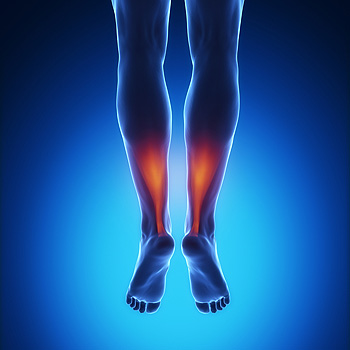 The tendon that connects the heel bone to the calf muscles is referred to as the Achilles tendon. This tendon is responsible for helping the feet push off the ground while walking, running, or jumping. It may become torn as a result of an injury that has happened to it. Many things can cause this to occur, including running uphill, participating in sporting activities that involve sharp turns, or possibly from falling. Some of the symptoms that are associated with this type of injury may include feeling pain and discomfort in the back of your ankle, having difficulty while standing on your tiptoes, or your leg may appear swollen. Mild relief may be found when the affected leg is elevated, and this may be helpful in reducing the swelling. If you have torn your Achilles tendon, it is suggested that you consult with a podiatrist who can offer proper treatment options.
The tendon that connects the heel bone to the calf muscles is referred to as the Achilles tendon. This tendon is responsible for helping the feet push off the ground while walking, running, or jumping. It may become torn as a result of an injury that has happened to it. Many things can cause this to occur, including running uphill, participating in sporting activities that involve sharp turns, or possibly from falling. Some of the symptoms that are associated with this type of injury may include feeling pain and discomfort in the back of your ankle, having difficulty while standing on your tiptoes, or your leg may appear swollen. Mild relief may be found when the affected leg is elevated, and this may be helpful in reducing the swelling. If you have torn your Achilles tendon, it is suggested that you consult with a podiatrist who can offer proper treatment options.
Achilles tendon injuries need immediate attention to avoid future complications. If you have any concerns, contact Dr. Steven Sheridan of Ankle & Foot Specialty Clinics. Our doctor can provide the care you need to keep you pain-free and on your feet.
What Is the Achilles Tendon?
The Achilles tendon is a tendon that connects the lower leg muscles and calf to the heel of the foot. It is the strongest tendon in the human body and is essential for making movement possible. Because this tendon is such an integral part of the body, any injuries to it can create immense difficulties and should immediately be presented to a doctor.
What Are the Symptoms of an Achilles Tendon Injury?
There are various types of injuries that can affect the Achilles tendon. The two most common injuries are Achilles tendinitis and ruptures of the tendon.
Achilles Tendinitis Symptoms
- Inflammation
- Dull to severe pain
- Increased blood flow to the tendon
- Thickening of the tendon
Rupture Symptoms
- Extreme pain and swelling in the foot
- Total immobility
Treatment and Prevention
Achilles tendon injuries are diagnosed by a thorough physical evaluation, which can include an MRI. Treatment involves rest, physical therapy, and in some cases, surgery. However, various preventative measures can be taken to avoid these injuries, such as:
- Thorough stretching of the tendon before and after exercise
- Strengthening exercises like calf raises, squats, leg curls, leg extensions, leg raises, lunges, and leg presses
If you have any questions please feel free to contact our office located in Sandusky, MI . We offer the newest diagnostic tools and technology to treat your foot and ankle needs.
